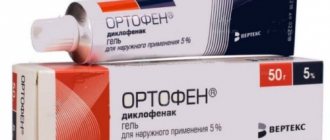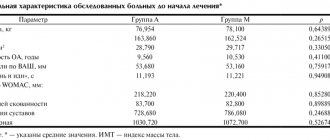Instructions for use FOSAVANCE
Alendronate.
Adverse reactions from the upper gastrointestinal tract
Alendronate may cause local irritation of the mucous membrane of the upper gastrointestinal tract. Because there is a potential for worsening of the underlying disease, alendronate should be used with caution in patients with active upper gastrointestinal disease, such as dysphagia, esophageal disease, gastritis, duodenitis, ulcers, or in patients with recent (within the past year) serious gastrointestinal disease. such as a peptic ulcer, active gastrointestinal bleeding, or upper gastrointestinal surgery other than pyloroplasty. In patients with Barrett's syndrome, physicians should individually evaluate the benefits and potential risks of alendronate.
Esophageal reactions (sometimes severe and requiring hospitalization), such as esophagitis, esophageal ulcers or esophageal erosions, rarely leading to esophageal stricture, have been reported in patients taking alendronate. Therefore, physicians should be alert to any signs or symptoms indicating a possible esophageal reaction, and patients should be aware to stop using the drug and seek medical attention if symptoms of esophageal irritation, such as dysphagia, pain with swallowing, or chest pain, occur. the appearance or worsening of heartburn.
The risk of severe esophageal adverse reactions is greater in patients who do not comply with alendronate recommendations and/or who continue to take alendronate after the onset of symptoms suggestive of esophageal irritation. It is very important that the patient knows and understands all instructions for using the drug. The patient should be aware that failure to follow these instructions may increase the risk of esophageal pathology. Although no increased risk has been observed in extensive clinical studies with alendronate, gastric and duodenal ulcers, sometimes severe and with complications, have been rarely reported (during post-marketing surveillance).
Osteonecrosis of the jaw
The development of osteonecrosis of the jaw, usually due to tooth extraction and/or local infection (including osteomyelitis), has been reported in patients with malignant diseases who are receiving treatment consisting primarily of intravenous bisphosphonates. Many of these patients also received chemotherapy and corticosteroids. Osteonecrosis of the jaw has also been reported in patients with osteoporosis who are taking oral bisphosphonates.
When assessing an individual's risk of developing osteonecrosis of the jaw, the following risk factors should be considered:
- bisphosphonate dosage (maximum for zoledronic acid), route of administration and total dose;
- cancer, chemotherapy, radiotherapy, corticosteroids, smoking;
- history of dental disease, poor oral hygiene, periodontal disease, invasive dental procedures, and improperly fitted dentures.
A dental examination with appropriate prophylactic treatment should be considered before initiating bisphosphonate treatment in patients with poor dental health.
During treatment, if possible, the patient should avoid undergoing invasive dental procedures. In patients who develop osteonecrosis of the jaw while on bisphosphonates, dental surgery may worsen the condition. For patients requiring dental procedures, there is no evidence to suggest that discontinuation of bisphosphonate treatment will reduce the risk of developing osteonecrosis of the jaw. The clinical judgment of the treating physician should be the basis of the treatment plan for each patient, based on an individual benefit/risk assessment.
During treatment with bisphosphonates, all patients should be advised to maintain good oral hygiene, have their teeth checked regularly, and report any oral symptoms such as tooth mobility, pain, or swelling.
Musculoskeletal pain
Bone, joint and/or muscle pain has been reported in patients taking bisphosphonates. During post-marketing surveillance, these symptoms were rarely severe and/or disabling. The period of time before symptoms appear varies from one day to several months after the start of treatment. Most patients experienced improvement in symptoms after stopping treatment. In some patients, symptoms recurred when the same drug or other bisphosphonates were used again.
Atypical femur fractures
Atypical subacetabular fractures and femoral shaft fractures have been reported during treatment with bisphosphonates, mainly in patients receiving long-term treatment for osteoporosis. These transverse or short oblique fractures can occur anywhere on the femur, from the area below the lesser trochanter to the area above the epicondyle. These fractures occurred after minor trauma (or no trauma); Some patients experienced hip or groin pain, often associated with imaging findings of stress fractures, occurring weeks or months before the complete femur fracture. Often the fractures were bilateral; Therefore, it is necessary to evaluate the contralateral femur in patients receiving bisphosphonate treatment who experience a femoral shaft fracture. Poor healing of such fractures has also been reported. Discontinuation of bisphosphonate treatment should be considered in patients with suspected atypical femoral fracture based on an individualized benefit-risk assessment of the patient's condition.
During treatment with bisphosphonates, patients should be aware of the need to tell their doctor if they experience pain in the thigh, hip, or groin area; Patients with these symptoms should be evaluated for an incomplete femoral fracture.
Renal dysfunction
Fosavance is not recommended for patients with impaired renal function with a glomerular filtration rate of less than 35 ml/min.
Metabolism in bone tissue and mineral metabolism.
Causes of osteoporosis other than estrogen deficiency and age should be considered.
Hypocalcemia should be corrected before starting treatment with Fosavance. Also, before starting to use Fosavance, other disorders affecting mineral metabolism (such as vitamin D deficiency and hypoparathyroidism) should be effectively treated. The amount of vitamin D contained in Fosavance is not sufficient to correct vitamin D deficiency. Patients with these conditions should be monitored for serum calcium levels and symptoms of hypocalcemia during treatment with Fosavance.
Due to the positive effect of alendronate on increasing bone mineral content, a decrease in serum calcium and phosphate levels may occur, particularly in patients taking glucocorticoids in whom calcium absorption may be reduced. Such changes are usually minor and asymptomatic. However, symptomatic hypocalcemia, sometimes severe and often occurring in patients with predisposing conditions (eg, hypoparathyroidism, vitamin D deficiency, and calcium malabsorption), has been rarely reported. Cholecalciferol.
Vitamin D3 may increase the severity of hypercalcemia and/or hypercalciuria when used in patients with diseases associated with unregulated excess production of calcitrol (for example, leukemia, lymphoma, sarcoidosis). In such patients, urine and serum calcium levels should be monitored. Patients with malabsorption may experience impaired absorption of vitamin D3.
Excipients
This drug contains lactose and sucrose. The drug should not be taken by patients with rare hereditary diseases such as fructose intolerance, galactose intolerance, Lapp lactase deficiency, glucose-galactose malabsorption or sucrase-isomaltase deficiency.
Impact on the ability to drive vehicles and operate machinery
Certain adverse reactions observed with the use of Fosavance may affect the ability to drive vehicles or operate machinery in some patients. Individual reactions to Fosavance may vary.
Fosavance forte 70mg+140mcg tab N4 (Merck)
Alendronate Adverse reactions from the upper gastrointestinal tract Alendronate may cause local irritation of the mucous membrane of the upper gastrointestinal tract. Due to the possibility of worsening the underlying disease while taking alendronate, caution should be exercised when prescribing the drug to patients with diseases of the upper gastrointestinal tract, for example, with dysphagia, esophageal disease, gastritis, duodenitis, ulcers, as well as with serious gastrointestinal disease suffered, in the previous 12 months, for example, peptic ulcer, gastrointestinal bleeding, surgery, surgery on the upper gastrointestinal tract, with the exception of pyroplasty. For patients diagnosed with Barrett's esophagus, the question of prescribing alendronate should be decided individually based on an assessment of the ratio of the expected benefit to the possible risk. During treatment with alendronate, there are known cases of adverse reactions from the esophagus (esophagitis, ulcer or erosion of the esophagus), sometimes severe, requiring hospitalization treatment, and in rare cases complicated by the formation of a stricture. Therefore, clinicians should pay special attention to any signs or symptoms indicating possible esophageal problems, and patients should be warned to stop taking alendronate and seek medical attention if symptoms of esophageal irritation, such as dysphagia, pain with swallowing, or chest pain, the appearance or worsening of heartburn. The risk of severe adverse events from the esophagus is higher in those patients who violate the recommendations for taking alendronate and/or continue to take it when symptoms of esophageal irritation appear. It is extremely important to fully inform patients about the importance of following medication guidelines and to ensure that they understand this. They should be warned that the risk of developing esophageal damage increases if these recommendations are not followed. Although no increased risk was observed in extended clinical trials of alendronate, rare cases of gastric and duodenal ulcers, sometimes severe and complicated, have been reported in post-marketing reports. Osteonecrosis of the jaw Osteonecrosis of the jaw has been reported in cancer patients treated with intravenous bisphosphonates. caused mainly by previous tooth extraction and/or local infection. (including osteomyelitis). Many of them also received chemotherapy and glucocorticosteroids. There are also known cases of osteonecrosis of the jaw in patients with osteoporosis when taking oral bisphosphonates. When assessing the individual risk of developing necrosis of the jaw, the following risk factors should be taken into account: - strength of the bisphosphonate (highest for zoledronic acid), route of administration (see above) and total dose; - cancer, chemotherapy, radiotherapy, glucocorticosteroids, smoking; - history of dental disease, poor oral hygiene, periodontal disease, invasive dental procedures and poorly fitted dentures. Before starting therapy with oral bisphosphonates, patients with unsatisfactory dental status are recommended to have a dental examination and preventive treatment measures. During the course of bisphosphonates, such patients are advised to avoid invasive dental procedures if possible. If a patient develops osteonecrosis while on bisphosphonate therapy, dental surgery may worsen the condition. It is unknown whether stopping bisphosphonates reduces the risk of osteonecrosis of the jaw in patients requiring dental procedures. In each case, the decision must be made by the attending physician based on an assessment of the ratio of the expected benefit to the possible risk for the individual patient. During bisphosphonate therapy, patients should be educated on the importance of proper oral hygiene, preventive examinations, and also warned them to report any oral symptoms , such as tooth mobility, pain or swelling. Pain in bones and muscles There have been cases of pain in bones, joints and/or muscles during a course of bisphosphonates. During post-marketing use, in rare cases these symptoms were severe and/or disabling. The time of onset of symptoms varied from one day to several months after the start of treatment. In most patients, symptoms resolved after cessation of treatment. In some, symptoms reappeared when the same drug or a different bisphosphonate was resumed. Atypical hip fractures Subtrochanteric or diaphyseal femoral fractures have been reported during treatment with bisphosphonates, mainly in patients receiving long-term therapy for osteoporosis. These transverse or oblique fractures can occur along the entire length of the femur from the lesser trochanter of the femur to the supracondylar extension. These fractures occur after minor or no trauma, and some patients experience severe pain in the hip or groin area, often accompanied by radiographic symptoms of stress fractures, weeks or months before the full picture of a hip fracture appears. Fractures are often bilateral, so the other (contralateral) hip should be evaluated in patients with a hip fracture taking bisphosphonates. It is known that these fractures heal poorly. If an atypical hip fracture is suspected, discontinuation of bisphosphonate therapy should be considered until an individual risk-benefit assessment is made. Patients should be advised to report any hip or groin pain during bisphosphonate therapy. All patients presenting with such complaints should be assessed for a hip fracture. Renal failure Fosavance Forte is contraindicated in patients with renal failure and glomerular filtration rate less than 35 ml per minute. Bone and mineral metabolism Causes of osteoporosis other than deficiency should be considered estrogen and age. In the presence of gicalcemia, the concentration of calcium in the blood must be normalized before starting treatment with Fosavance Forte. Other disorders of mineral metabolism (for example, vitamin D deficiency and hypoparathyroidism) should also be effectively treated before starting treatment with Fosavance Forte. The vitamin D content of Fosavance Forte is not sufficient to correct hypovitaminosis D. In patients with these disorders, serum calcium concentrations and symptoms of hypocalcemia should be monitored during treatment with Fosavance Forte. Since alendronate increases bone mineral content, a decrease in calcium and phosphate levels may be observed in the blood serum, especially when taking glucocorticosteroids that reduce calcium absorption. Usually this decrease is small and asymptomatic. However, there are rare cases of symptomatic hypocalcemia, which sometimes reaches a severe degree and develops in patients with a corresponding predisposition (for example, hypoparathyroidism, hypovitaminosis D and calcium malabsorption). Colecalciferol Vitamin D3 may increase the severity of hypercalcemia and/or hypercalciuria when used in patients with diseases that cause uncontrolled hyperproduction of calcitriol (for example, leukemia, lymphoma, sarcoidosis). In such patients, it is necessary to monitor calcium levels in urine and serum. Patients with malabsorption may experience impaired absorption of vitamin D3. Excipients This medicinal product contains lactose and sucrose. Patients with rare hereditary diseases of fructose and galactose intolerance, lactase deficiency, glucose-galactose malabsorption and sucrase-isomaltase deficiency should not take this drug. Effect on the ability to drive a car and other mechanisms There is no evidence that Fosavance Forte directly affects the ability drive a car or use other machinery. Some adverse events; for example, blurred vision, dizziness, severe pain in the joints or muscles (see section "Side effects"), observed when taking Fosavance Forte, may affect the ability to drive a car and other mechanisms.
Fosavance®
Fosavance®, like other bisphosphonates, may cause local irritation of the mucous membrane of the upper gastrointestinal tract.
Patients treated with Fosavance may experience adverse reactions such as esophagitis, ulceration and erosion of the esophagus, rarely leading to strictures or perforation of the esophagus. In some cases, these adverse events may be severe and require hospitalization. Therefore, physicians should be especially alert for any signs or symptoms indicating possible esophageal problems, and patients should be warned to stop taking Fosavance and seek medical attention if they experience dysphagia, pain with swallowing, or sternum, the appearance or worsening of heartburn.
The risk of severe esophageal adverse events is higher in those patients who do not follow the drug dosage recommendations and/or continue to take the drug when symptoms of esophageal irritation occur. It is especially important that the patient has recommendations for taking the drug, understands them, and is informed that the risk of developing esophageal damage increases if these recommendations are not followed.
There are rare cases of stomach and duodenal ulcers, sometimes severe and complicated. However, in these cases, a cause-and-effect relationship with taking the drug has not been established.
Fosavance® should be prescribed with caution to patients with exacerbations of diseases of the upper gastrointestinal tract, such as dysphagia, diseases of the esophagus, gastritis, duodenitis and ulcers due to the possible irritant effect of the drug on the mucous membrane of the upper gastrointestinal tract and worsening of the underlying disease.
There are known cases of local osteonecrosis of the jaw, associated mainly with previous tooth extraction and/or local infection, due to untimely treatment, when taking oral bisphosphonates. Most of these cases have been reported in cancer patients treated with intravenous bisphosphonates. Known risk factors for the development of necrosis of the jaw include detection of cancer, appropriate treatment (chemotherapy, radiotherapy, corticosteroids), poor oral hygiene and comorbidities (dental disease, anemia, coagulopathy, infections). Patients who have localized osteonecrosis of the jaw should consult an oral and maxillofacial surgeon.
Fosavance® is not recommended for use in patients with severe renal failure (creatinine clearance<35 ml/min) due to the lack of experience in this category of patients.
Causes of osteoporosis other than estrogen deficiency, age, and the use of corticosteroids should be taken into account.
In the presence of hypocalcemia, the level of calcium in the blood must be normalized before starting treatment with Fosavance. Other disorders of mineral metabolism (for example, vitamin D deficiency) should also be corrected. Patients with these disorders should be monitored for blood calcium levels and symptoms of hypocalcemia.
Because alendronate sodium increases bone mineral content, small asymptomatic decreases in serum calcium and phosphorus levels may occur.
Vitamin D supplementation may be considered on an individual basis.
Vitamin D3 may increase the severity of hypercalcemia and/or hypercalciuria when used in patients with diseases associated with overproduction of calcitriol (leukemia, lymphoma, sarcoidosis). Plasma and urine calcium levels should be monitored in such patients.
Patients with malabsorption may have impaired absorption of vitamin D.
Impact on the ability to drive vehicles and operate machinery
There is no evidence that Fosavance® affects the ability to drive or use machinery.


